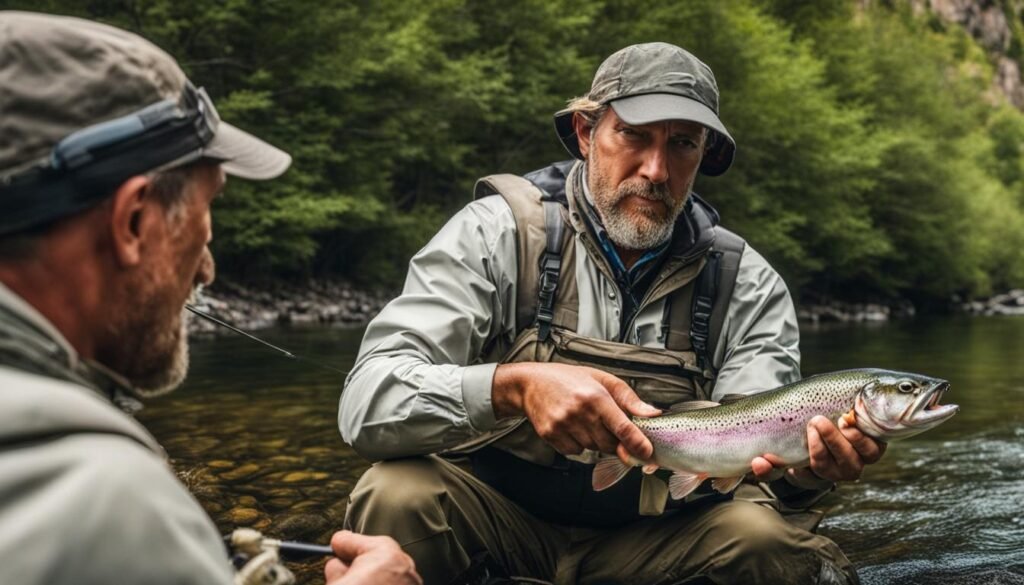Proper fly fishing conduct is crucial for maintaining a positive and enjoyable atmosphere on the water. It ensures that everyone can pursue their passion without conflicts or frustrations. By following the guidelines we will share in this guide, you will be well-equipped to navigate the waters with respect for fellow anglers, handle fish with care, and create a peaceful environment. So, let’s get started and learn the fly fishing etiquette that will elevate your angling experience!
Fishing Etiquette Guidelines for a Respectful Fly Fishing Experience
Giving Space and Right of Way
When approaching a river or fishing area, always be mindful of other anglers. If the river is crowded, it is best to assume that anglers are working upstream and give them the right of way. Make sure to ask if the angler is working up or down and adjust your fishing accordingly. In addition, when passing other anglers, take a wide berth to avoid spooking the fish and disrupting their fishing experience.
Rotating Through Runs
To ensure fairness and promote a sense of camaraderie, it is important to rotate through a run rather than camping out in one spot all day. This allows other anglers to have an opportunity to fish various sections of the river and increases everyone’s chances of success. By being considerate and sharing the fishing opportunities, you contribute to creating a more inclusive and respectful fly fishing community.
Maintaining a Positive Attitude
Lastly, it is essential to maintain a positive attitude and respectful demeanor on the water. Fly fishing is meant to be a relaxing and enjoyable experience, and it is important to keep noise levels low and avoid disruptive behavior. By being mindful of your surroundings, like not splashing or stirring up the water unnecessarily, you help preserve the serenity of the fishing environment and show respect for both nature and fellow anglers.
Fishing Etiquette Tips: Handling Fish with Care

Proper Catch and Release Techniques
If you practice catch and release, it’s essential to learn and implement proper release techniques. This will help minimize stress and injury to the fish. When handling a fish, wet your hands first to avoid removing its protective slime layer. Keep the fish in the water as much as possible, only lifting it briefly for a quick photo if desired. Remember, trout, in particular, are delicate creatures, so limit their time out of the water to five to six seconds.
Using Barbless Hooks
Using barbless hooks is another important aspect of responsible fishing. Barbless hooks are easier to remove from the fish’s mouth, reducing potential harm. They also increase the chances of a successful catch and release. Consider replacing your hooks with barbless ones or simply crimping down the barbs on your existing hooks. This small adjustment can make a significant difference in the fish’s overall well-being.
Minimizing Handling Time
To ensure the fish’s safety, it’s crucial to minimize their handling time. The less time you spend handling the fish, the better its chances of survival. When unhooking a fish, do it swiftly and gently, using proper tools such as forceps or pliers. Avoid excessive touching or squeezing of the fish, as it can cause internal injuries. By reducing handling time, you’re maximizing the fish’s chances of thriving after release.
Creating a Peaceful Environment
When it comes to fly fishing etiquette, one of the key aspects is creating a peaceful environment on the water. It’s important to remember that you’re not just there to catch fish, but also to enjoy the tranquility of nature. Keep your voices low and avoid excessive noise that can disturb the serenity of the wilderness. By being mindful of the volume of your conversations, you can contribute to a peaceful atmosphere that allows everyone to fully immerse themselves in the beauty of their surroundings.
Another way to create a peaceful environment is by being considerate of other anglers. Avoid back-casting in crowded areas to prevent tangling lines or accidentally hooking someone. Always be aware of your surroundings and adjust your casting technique accordingly. By doing so, you’ll not only avoid causing frustration or accidents but also maintain a harmonious atmosphere where everyone can fish without interference.
It’s essential to be mindful of the water itself. Avoid splashing or stirring up the water unnecessarily, as it can disturb the fish and make them more cautious. Take care when wading to minimize your impact on the riverbed, and be considerate of others by giving them space to fish comfortably. By treating the water with respect, you’ll contribute to a peaceful environment that benefits both the fish and your fellow anglers.

